GMAT 2019 Question Paper with Answer Key and Solutions PDF is available for download. GMAT lasts for a total of 2 hours and 15 minutes, with an optional 10-minute break. Throughout the test, candidates will be required to answer 64 questions, distributed as follows:
- Quantitative Reasoning: 21 questions, to be completed in 45 minutes.
- Verbal Reasoning: 23 questions, to be completed in 45 minutes.
- Data Insights: 20 questions, to be completed in 45 minutes.
GMAT 2019 Question Paper with Solutions PDF
Question 1:
For chocolates prevalent in the market and consumed widely by children, if the absence of labeling that indicates the ingredients seems dangerous, then the certifying body can require that the chocolate undergoes paediatric study.
- (A) that the chocolate undergoes
- (B) that the chocolate undergo
- (C) that the chocolate is to undergo
- (D) the chocolate undergoing
- (E) the chocolate to have to undergo
Question 2:
The central idea of the passage is
- (A) Discuss the origin of AGI
- (B) Explain why AGI has failed to achieve its goal
- (C) Compare the differences in the ideologies of Progressive and Ethical Scientists
- (D) Discuss an oversight that can cost us dearly
- (E) Revise a thought held by Ethical Scientists
Question 3:
The view that “this doubt stems out, not from what is unseen but out of what exists” refers to which one of the following?
- (A) Resistance of Ethical Scientists
- (B) Progressive Scientists’ belief that the fear of unknown leads to the skepticism of the Ethical Scientists
- (C) Ethical Scientists’ fear of the “unknown”
- (D) Author’s belief that there was a lack of consensus between the Ethical and the Progressive Scientists
- (E) Ethical Scientists’ fear of the consequences of what this progress entails
Question 4:
The author of the passage asserts which one of the following about the Progressive scientists?
- (A) They attacked the Ethical Scientists in an unrestrained manner
- (B) They underscored the problems foreseen by the Ethical Scientists
- (C) They need to be more serious about the questions raised by the Ethical Scientists
- (D) They were correct in avoiding doubts raised by the Ethical Scientists
- (E) Though they were treated with skepticism, they overcame the challenges
Question 5:
What is the attitude of Progressive Scientists towards Ethical Scientists?
- (A) spiteful and envious
- (B) Reverent and idolatry
- (C) ignorant and condescending
- (D) ambivalent but deferential
- (E) uncertain but interested
Question 6:
The results of the recent diet program that was launched early this year are evident in all the participants’ average weight, which reduced by almost 7kg on an average during the first 2 months of the program after it increased by 8% in the last three years.
- (A) which reduced by almost 7kg on an average during the first two months of the program after it increased
- (B) which had reduced by almost 7kg on an average during the first two months of the program after it had increased
- (C) which has increased by almost 7kg on an average during the first two months of the program after it increased
- (D) with a 7kg reduction on an average during the first two months of the program after increasing
Correct Answer: (B) which had reduced by almost 7kg on an average during the first two months of the program after it had increased
View Solution
Step 1: Understand the tense and structure.
The passage describes a sequence of events: first, the weight increased, and then it decreased. The correct option must reflect this past sequence using the past perfect tense ("had reduced").
Step 2: Analysis of options.
- (A) which reduced by almost 7kg on an average during the first two months of the program after it increased: Incorrect, as it uses the simple past tense, which doesn't reflect the prior increase properly.
- (B) which had reduced by almost 7kg on an average during the first two months of the program after it had increased: Correct. This option correctly uses the past perfect tense, reflecting the sequence of the weight increase and then reduction.
- (C) which has increased by almost 7kg on an average during the first two months of the program after it increased: Incorrect. This uses the present perfect tense, which doesn't fit the sequence.
- (D) with a 7kg reduction on an average during the first two months of the program after increasing: Incorrect. This structure is awkward and doesn't properly reflect the sequence of events.
Step 3: Conclusion.
The correct answer is (B).
Quick Tip: Pay attention to the tense when describing a sequence of events, especially with past actions.
Question 7:
Which of the following, if true, casts the most doubt on the effectiveness of the solution proposed above?
- (A) In many American countries, satisfactory taste and low-cholesterol content are believed to be entirely contradictory.
- (B) The market for oils such as coconut and palm has been slowly shrinking in many American countries due to the emergence of specialized cholesterol-free oils.
- (C) Company Slim-fit could only feasibly maintain such a marketing budget for 10 to 12 months before scaling down the campaign.
- (D) After Company Slim-fit attempted a similar marketing strategy in South Asia, the sales of the new product greatly increased.
- (E) In California, the new low-cholesterol oil substitute achieved a market share of 10% within the first year – without any massive marketing campaign.
Question 8:
Which of the following, if true, most seriously weakens the conclusion above?
- (A) Some symptoms normally associated with Sodium consumption may resemble symptoms caused by prescription drugs or even drowsiness.
- (B) Increases in BSC are based on the amount of Sodium consumed rather than the number of foods (some foods contain more Sodium than others).
- (C) Heavy Sodium consumption has numerous long term effects such as stomach ulcers, cirrhosis of the liver, and birth defects.
- (D) The metabolic rate of Sodium varies according to a person’s weight, diet, health, and genetic predispositions.
- (E) Some people, due to an acute sensitivity to Sodium, cannot even reach a BSC of 0.18 before becoming violently ill.
Question 9:
The design of the neck muscles and the spinal bones of the molluscs allow that it can pull in the exposed parts of the body such that the predator doesn’t find anything but a hard shell to bite.
- (A) allow that it can pull in the exposed parts of the body such that
- (B) allow it to pull in its exposed parts, such that
- (C) allows that it can draw in its exposed parts, and so
- (D) allows for it to draw in its exposed part, and that
- (E) allows it to draw in its exposed parts, so that
Question 10:
Three out of every five Apple phone users in China also use an Android phone.
- (A) Three out of every five Apple phone users in China also use an Android phone.
- (B) Out of every five, three Apple phone users in China also uses an Android phone.
- (C) Android Phones are used by every three out of five Apple phone users in China.
- (D) In China, three out of every five Apple phone users uses Android phones
- (E) Out of every five Apple phone users in China, Android phones are used by three.
Question 11:
In the state of California, the number of people who this year died due to heart attack are less than cancer.
- (A) are less than
- (B) are fewer than
- (C) is less than those who died due to
- (D) is less than the number of people who died due to
- (E) is less than that of people who died due to
Question 12:
The main purpose of the author is to
- (A) Criticize the people who ask others to adopt the American philosophy
- (B) Challenge the political philosophies of countries other than America
- (C) Suggest an alternate way of looking at political theory of America
- (D) Explain the complexities faced by the American genius
- (E) Argue why a country cannot theorize its achievement
Question 13:
The author sets of the word “grammar” with quotation marks in order to
- (A) Emphasize its departure from the concepts of philosophy
- (B) Indicate that the word is his favorite
- (C) Assert that the nation is disinterested in political theory
- (D) Show that people have overemphasized theory behind grammar
- (E) Highlight his aversion to the word
Question 14:
The argument relies on assuming which one of the following?
- (A) Processing milk chocolate costs more than does processing dark chocolate.
- (B) Price discrepancy between the products can usually be accounted for by such factors as supply-demand but not by the differences in production costs.
- (C) There is little competition among companies that process dark chocolates.
- (D) Retail chocolate-sellers do not believe that chocolate-lovers are content to pay more for dark chocolate than for milk chocolate.
- (E) The ingredients used for producing dark chocolate do not cost much more before processing than the ingredients used for producing milk chocolate.
Question 15:
Which of the following would be the most useful to establish in evaluating the recommendation of the consultant?
- (A) Whether other markets, such as flour mills and power stations, would offer greater opportunities for potential profits.
- (B) Whether the number of upright drive-belt motors at any single work place is greater than the number of pieces of equipment requiring cleaners on a single firm.
- (C) How the ambient space quality in a upright drive-belt suction technology compares to the typical space quality in an commercial cleaning set-up.
- (D) Whether the competition in the upright drive-belt suction technology sector would allow for profits similar to what those in the commercial cleaning equipment sector had been.
- (E) Whether countries with expanding commercial sectors would use cleaning equipment similar to cleaners currently served by Clear-space.
Question 16:
The argument is most vulnerable to criticism on which of the following grounds?
- (A) It simply doesn’t take into account the existence of potential counter-premise.
- (B) It generalizes from one of its kind occurrences.
- (C) It presumes what it seeks to establish.
- (D) It depends on the judgment of specialists in a matter where their specialty is irrelevant.
- (E) It infers limits on ability from a few standalone lapses in performance.
Question 17:
Unlike the opinion held by many of his peers that lasers were relatively simple, Arthur Ashkin adhered to his own more complicated ideas about how lasers might operate, and in 2018, at the age of 96, was awarded a Nobel Prize for his invention of 'optical tweezers'.
- (A) Unlike the opinion held by many of his peers that lasers were relatively simple
- (B) Unlike the opinion held by many of his peers that lasers were relatively simple
- (C) Compared to many of his peers’ opinions that lasers were relatively simple
- (D) Even though many of his peers were convinced that lasers were relatively simple
- (E) Even with many of his peers convinced of lasers being relatively simple
Question 18:
Unemployment benefits in the United States did not only support recession struck individuals, create opportunities for volunteerism, and had covered their expenses, but also cause minimum wage employees to quit their jobs.
- (A) Unemployment benefits in the United States did not only support recession struck individuals, create opportunities for volunteerism, and had covered their expenses, but also
- (B) Unemployment benefits in the United States not only supported recession struck individuals, created opportunities for volunteerism, and covered the expenses of the unemployed, but also
- (C) Unemployment benefits in the United States did not only support recession struck individuals, create opportunities for volunteerism, and cover the expenses of the unemployed, but also
- (D) Unemployment benefits in the United States supported not only recession struck individuals, create opportunities for volunteerism, and cover their expenses, but also they
- (E) Unemployment benefits in the United States did not only support recession struck individuals, create opportunities for volunteerism, and cover their expenses, at the same time
Question 19:
In the last century, the Indian population has grown faster than China, Brazil, or Russia, with the economy having remained well below that of the other three countries.
- (A) China, Brazil, or Russia, with the economy having remained
- (B) has those of China, Brazil, or Russia, and the economy remaining
- (C) the Chinese, the Brazilian, or the Russian economy having remained
- (D) Compared to many of his peers' opinions that lasers were relatively simple
- (E) Even with many of his peers convinced of lasers being relatively simple
Question 20:
Which of the following, if true, most strengthen the argument above?
- (A) A good number of industries that have switched at least partly to new technologies have increased their output.
- (B) Less energy, generated from non-renewable energy source, was used to manufacture the machinery employed in the new technologies than was originally used to manufacture the machinery employed in the older technologies.
- (C) More energy, generated from renewable energy source, is used to by those industries that have switched at least partly to the new technologies than by those industries that have not switched.
- (D) Some of the industries that have switched at least partly to the new technologies still primarily use technologies that are powered by non-renewable energy source.
- (E) The amount of energy, generated from non-renewable energy source, used to generate the electricity needed to power the new technologies is less than amount that would have been used to power the older technologies.
Question 21:
Which of the following is an assumption required by this argument?
- (A) At least some participants who said they had acted fairly in choosing the familiar task would have said that it was unfair for someone else to do so.
- (B) The most moral choice for the people would have been to have the computer assign the two tasks randomly.
- (C) There were at least some persons who were assigned to do the unfamiliar task and felt that the assignment was unfair.
- (D) On average, the people to whom the scenario was described were more accurate in their moral judgments than the other volunteers were.
- (E) At least some people given the choice between assigning the tasks themselves and having the computer assign them felt that they had made the only fair choice available to them.
Question 22:
On which of these grounds is the debater’s argument most vulnerable to criticism?
- (A) It takes for granted that the designing division is a typical division of the corporation with regard to the average amount of overtime its employees work each month.
- (B) It takes for granted that if a certain average amount of overtime is worked each month by each employee of the Power Corporation, then approximately the same amount of overtime must be worked each month by each employee of the designing division.
- (C) It confuses a claim from which the argument’s conclusion about the Power Corporation would necessarily follow with a claim that would follow from the argument’s conclusion only with a high degree of probability.
- (D) It overlooks the possibility that even, on average, a certain amount of overtime is worked by the members of some group, many members of that group may work no overtime at all.
- (E) It overlooks the possibility that even, on average, a certain amount of overtime is worked by the members of some group, and many members of the corporation work some overtime each month, but some employees may work none at all.
Question 23:
What does the passage do as a whole?
- (A) Explains why self-assembly is the best approach to make integrated circuits.
- (B) Explains how the “top-bottom” approach is better than the “bottom-up approach.”
- (C) Shows how the “bottom-up” and the “top-bottom approach” can both complement and hinder the development of nano- scaling techniques.
- (D) Discusses how “top-bottom approach” has been discarded because of the new approach.
- (E) Reasons that future necessitates an innovative approach.
Question 24:
According to the author, the primary difficulty in using top-bottom approach is that
- (A) The new approach is easier to work with.
- (B) The task of working on ever-smaller dimensions is way too complicated for the approach.
- (C) This process has worked since 1950s till now only.
- (D) It is not future ready.
- (E) It is as tedious a task as exposing a negative on photographic paper.
Correct Answer: (B) The task of working on ever-smaller dimensions is way too complicated for the approach.
View Solution
Step 1: Identify the primary challenge discussed in the passage.
The author discusses how as technology advances and the need for smaller devices increases, the traditional top-down approach becomes increasingly difficult to use for nano-scale devices.
Step 2: Analysis of options.
- (A) The new approach is easier to work with: This is incorrect because the new approach is not described as easier, but rather as a complementary method to the top-down approach.
- (B) The task of working on ever-smaller dimensions is way too complicated for the approach: Correct. The passage discusses how as the dimensions get smaller, the top-down approach becomes less effective.
- (C) This process has worked since 1950s till now only: The passage mentions the long use of top-down processes, but it doesn’t say this is the primary challenge.
- (D) It is not future ready: The passage does not claim that the top-down approach is not future ready, but rather that it needs to be supplemented by new techniques.
- (E) It is as tedious a task as exposing a negative on photographic paper: This is used as an analogy for the complexity of the task but is not the primary difficulty identified.
Step 3: Conclusion.
The correct answer is (B), as it directly addresses the primary challenge described in the passage.
Quick Tip: Look for challenges related to limitations in technology, especially when working with smaller dimensions or more complex requirements.
Question 25:
Why does the author use the example of water splashing on a pane of glass?
- (A) Explain how integrated circuits can be made only by self-assembly.
- (B) To provide an analogy for the combined method.
- (C) To illustrate bottom-up approach.
- (D) To raise questions about bottom-up approach.
Question 26:
Which of the following best expresses the function of the first paragraph in relation to the passage as a whole?
- (A) To establish the parameters of an ensuing debate.
- (B) To identify problems in one of the processes, which are then explored in greater details.
- (C) To provide a backdrop for a discussion of a modern day approach.
- (D) To discuss an existing prototype that the author admires.
- (E) To introduce opposing viewpoints, which are then evaluated.
Question 27:
Which of the following titles best summarizes the passage as a whole?
- (A) A look at the history of nanostructures
- (B) Pointing out limited usefulness of the “top-down” process
- (C) Detailed study of transistors
- (D) At the threshold of new approach
- (E) How top-bottom approach works
Question 28:
The 22-year-old choreographer and actor performed his most recent work all over Europe, Asia, and North America last year, winning prestigious awards in both France as well as Japan for his achievement at so young an age, and he is hoping to continue acting now that he has returned to India.
- (A) winning prestigious awards in both France as well as Japan for his achievement at so young an age, and he is hoping
- (B) winning prestigious awards in both France as well as Japan for his achievement at such a young age, hoping
- (C) winning prestigious awards both in France and Japan for his achievement at such a young age, and hoping
- (D) winning prestigious awards both in France as well as Japan for his achievement at so young an age, and hoping
- (E) having won prestigious awards both in France as well as Japan for his achievement at so young an age, and he hopes
Question 29:
Rajasthan village crafts, as with other cultures, have developed through the principle that form follows function and incorporate readily available materials fashioned using traditional skills.
- (A) as with
- (B) as those of
- (C) as they have in
- (D) like in
- (E) like those of
Question 30:
Almost like clones in their similarity to one another, the penguin species’ homogeneity makes them especially vulnerable to disease.
- (A) the penguin species’ homogeneity makes them especially vulnerable to disease
- (B) the penguin species is especially vulnerable to disease because of its homogeneity
- (C) the homogeneity of the penguin species makes it especially vulnerable to disease
- (D) homogeneity makes members of the penguin species especially vulnerable to disease
- (E) members of the penguin species are especially vulnerable to disease because of their homogeneity.
Question 31:
Which of the following, if true, most strengthens the argument?
- (A) The population of sea urchins, the main food of seal fishes, has increased since the seal fish population declined.
- (B) Otters do not eat seal fishes, nor do they compete with seal fishes for food.
- (C) Most of the surviving seal fishes live in a bay that is inaccessible to whales.
- (D) The population of whales in the Siargao Islands has declined since the 1960s.
- (E) An increase in commercial fishing near the Siargao Islands in the 1960s caused a slight decline in the population of the fish that seals use for food.
Question 32:
According to the author, a deconstructive study would be successful if it
- (A) studies the artwork in reference to a fixed set of ideas and values
- (B) Invests more time in observation of art work
- (C) Is dispassionate about the literary work
- (D) Takes into account the preferences of the author
- (E) Focuses on the peculiar structure of the literary work
Question 33:
Which of the option below could describe tone of the author towards a deconstructive study?
- (A) Peculiar but interesting
- (B) Unbiased and systematic
- (C) Challenging but practical
- (D) Impractical and problematic
- (E) Unnecessary and pointless
Question 34:
With privacy concerns, such as private entities accessing, using and possibly misusing biometric data plaguing the ever connected digitalized world, the makers of privacy law seems to be in a dilemma as they often have no existing framework to define the scope of sensitive personal data, like political and religious views, ethnicity and biometric data, also, what should be available in the public domain for one and all to see.
- (A) The makers of privacy law seems to be in a dilemma as they often have no existing framework to define the scope of sensitive personal data, like political and religious views, ethnicity and biometric data, also, what should be available in the public domain for one and all to see.
- (B) Lawmakers seem to be in a dilemma as it often has no existing framework to define the scope of sensitive personal data, such as political and religious views, ethnicity and biometric data, also, what should be available in the public domain for one and all to see.
- (C) Over political and religious views, ethnicity and biometric data, and, what should be available in the public domain for one and all to see, the makers of privacy law are in a dilemma as they often have no existing framework to define the scope of sensitive personal data.
- (D) Over political and religious views, ethnicity and biometric data, also, what should be available in the public domain for one and all to see, the makers of privacy law are in a dilemma as they often have no existing framework to define the scope of sensitive personal data.
- (E) Lawmakers are in a dilemma as they often have no existing framework to define the scope of sensitive personal data, such as political and religious views, ethnicity and biometric data, and, what should be available in the public domain for one and all to see.
Question 35:
In May of 1832, The Opening of Waterloo Bridge, John Constable's view of Waterloo Bridge over the Thames sold for £18.5 million and it was the third highest price ever paid for a painting at auction.
- (A) Thames sold for £18.5 million and it was
- (B) Thames, which sold for £18.5 million, was
- (C) Thames, was sold for £18.5 million
- (D) Thames sold for £18.5 million, being
- (E) Thames, sold for £18.5 million, and was
Question 36:
For members of the sixteenth century Venezuela nation in America, jaguar-hide shields with stone frames were essential items of military equipment, a medium to shield combatants against enemy arrows and spears.
- (A) a medium to shield
- (B) as a pattern shielding
- (C) shielding
- (D) as a shield to
- (E) to shield
Question 37:
What is the area of the circle shown above with center O?
![]()
(1) W is the mid-point of chord XY.
(2) The ratio of ZW to OW is 3:5.
- (A) Statement 1 alone is sufficient but statement 2 alone is not sufficient to answer the question asked.
- (B) Statement 2 alone is sufficient but statement 1 alone is not sufficient to answer the question asked.
- (C) Both statements 1 and 2 together are sufficient to answer the question but neither statement is sufficient alone.
- (D) Each statement alone is sufficient to answer the question.
- (E) Statements 1 and 2 are not sufficient to answer the question asked and additional data is needed to answer the statements.
Question 38:
If \( A^4 + B^4 = 100 \), then the greatest possible value of A is between
- (A) 0 and 3
- (B) 3 and 6
- (C) 6 and 9
- (D) 9 and 12
- (E) 12 and 15
Question 39:
In the above figure, if \( y+z = 280 \), what is the degree measure of angle \( x \)?
![]()
- (A) 120
- (B) 100
- (C) 90
- (D) 80
- (E) 60
Question 40:
In a circus company the price of tickets for adult and children were
(50 and
)30 respectively. The company has sold a total of 1000 tickets. The average (arithmetic mean) price per ticket sold was
(42. How many tickets were sold for children?
- (A) 200
- (B) 300
- (C) 400
- (D) 600
- (E) 800
Question 41:
There are two vessels. In the first vessel, the ratio of milk to water is 2:3, and in the second vessel the milk and water are in the ratio 3:5. In what ratio the contents in two vessels must be mixed such that the resulting mixture will have milk and water in the ratio 5:8?
- (A) 1:3
- (B) 3:10
- (C) 3:5
- (D) 10:3
- (E) Cannot be determined
Question 42:
A chemical factory produces two kinds of unnatural amino acids: acid A and acid B. Of the acids produced by the factory last year, \( \frac{1}{3} \) were acid A and the rest were acid B. If it takes \( \frac{2}{5} \) as many hours to produce acid B per unit as it does to produce acid A per unit, then the number of hours it took to produce the acid B last year was what fraction of the total number of hours it took to produce all the acids?
- (A) \( \frac{2}{5} \)
- (B) \( \frac{4}{9} \)
- (C) \( \frac{17}{35} \)
- (D) \( \frac{1}{2} \)
- (E) \( \frac{5}{9} \)
Question 43:
The figure above represents a picture set in a square wooden frame that is \( p \) inches wide on all sides. If the combined area of picture and the frame is equal to \( q \) square inches, then in terms of \( p \) and \( q \), what is the perimeter of the picture?
![]()
- (A) \( -8p + 4q \)
- (B) \( 2p + 2q \)
- (C) \( (-2p + \sqrt{q})^2 \)
- (D) \( 4(\sqrt{q - p} - p) \)
- (E) \( 4\sqrt{q} - 8p \)
Question 44:
Is parallelogram PQRS a rhombus?
(1) \( PQ = QR = RS = SP \)
(2) The line segments SQ and RP are perpendicular bisectors of each other.
- (A) Statement 1 alone is sufficient but statement 2 alone is not sufficient to answer the question asked.
- (B) Statement 2 alone is sufficient but statement 1 alone is not sufficient to answer the question asked.
- (C) Both statements 1 and 2 together are sufficient to answer the question but neither statement is sufficient alone.
- (D) Each statement alone is sufficient to answer the question.
- (E) Statements 1 and 2 are not sufficient to answer the question asked and additional data is needed to answer the statements.
Question 45:
If \( y - x > x + y \), where \( x \) and \( y \) are integers, which of the following must be true?
- (A) \( x < 0 \)
- (B) \( y > 0 \)
- (C) \( x < y \)
- (D) \( x < 0 \) and \( y > 0 \)
- (E) \( x > 0 \) and \( y > 0 \)
Question 46:
If \( p < x < q \) and \( r < y < s \), is \( x > y \)?
(1) \( p < r \)
(2) \( q < r \)
- (A) Statement 1 alone is sufficient but statement 2 alone is not sufficient to answer the question asked.
- (B) Statement 2 alone is sufficient but statement 1 alone is not sufficient to answer the question asked.
- (C) Both statements 1 and 2 together are sufficient to answer the question but neither statement is sufficient alone.
- (D) Each statement alone is sufficient to answer the question.
- (E) Statements 1 and 2 are not sufficient to answer the question asked and additional data is needed to answer the statements.
Question 47:
A book shop sold a set of Harry Potter books to a book collector for 40 percent more than the store had originally paid for the books. When the collector tried to resell the books to the store, the store bought it back at 50 percent of what the book collector had paid. The shop then sold the book again at a profit of 70 percent on its buy-back price. If the difference between the series of book's original cost to the shop and the book's buy-back price was
(100, for approximately how much did the shop sell the books the second time?
- (A) 600
- (B) 567
- (C) 560
- (D) 333
- (E) 330
Question 48:
By what percent was the price of a certain Tab discounted for a sale?
(1) The price of the tab was sold with a discount of
(50.
(2) The price of the tab before it was discounted for the sale was 25 percent greater than the discounted price.
- (A) Statement 1 alone is sufficient but statement 2 alone is not sufficient to answer the question asked.
- (B) Statement 2 alone is sufficient but statement 1 alone is not sufficient to answer the question asked.
- (C) Both statements 1 and 2 together are sufficient to answer the question but neither statement is sufficient alone.
- (D) Each statement alone is sufficient to answer the question.
- (E) Statements 1 and 2 are not sufficient to answer the question asked and additional data is needed to answer the statements.
Question 49:
The colored roses in the bouquet of flowers are red, yellow, and pink. The ratio of the number of red to the number of yellow to the number of pink in the closet is 7:4:6, respectively. If there are more than 7 yellow colored roses, what is the minimum number of total roses in the bouquet?
- (A) 8
- (B) 12
- (C) 14
- (D) 24
- (E) 34
Question 50:
If Polygon A has fewer than 10 sides and the sum of the interior angles of polygon A is divisible by 16, how many sides does Polygon A have?
- (A) 4
- (B) 5
- (C) 6
- (D) 7
- (E) 8
Question 51:
In the figure above, PRS is a triangle, what is the measure of the angle PSQ?
(1) \( QS = QR = 1 \)
(2) \( PR = 2 \)
![]()
- (A) Statement 1 alone is sufficient but statement 2 alone is not sufficient to answer the question asked.
- (B) Statement 2 alone is sufficient but statement 1 alone is not sufficient to answer the question asked.
- (C) Both statements 1 and 2 together are sufficient to answer the question but neither statement is sufficient alone.
- (D) Each statement alone is sufficient to answer the question.
- (E) Statements 1 and 2 are not sufficient to answer the question asked and additional data is needed to answer the statements.
Question 52:
In the diagram above, triangle PQR has a right angle at Q. What is the ratio of the area of triangle PQS to the area of triangle QRS?
(1) Line segment \( QS \) is perpendicular to \( PR \) and has a length of 12.
(2) PQR has a perimeter of 60.
![]()
- (A) Statement 1 alone is sufficient but statement 2 alone is not sufficient to answer the question asked.
- (B) Statement 2 alone is sufficient but statement 1 alone is not sufficient to answer the question asked.
- (C) Both statements 1 and 2 together are sufficient to answer the question but neither statement is sufficient alone.
- (D) Each statement alone is sufficient to answer the question.
- (E) Statements 1 and 2 are not sufficient to answer the question asked and additional data is needed to answer the statements.
Question 53:
In a certain show, a lottery ticket is numbered consecutively from 100 through 999 (both inclusive). What is the probability that a randomly selected ticket will have a number with a ten’s digit as “3”?
- (A) \( \frac{1}{5} \)
- (B) \( \frac{90}{899} \)
- (C) \( \frac{1}{10} \)
- (D) \( \frac{1}{11} \)
- (E) \( \frac{10}{111} \)
Question 54:
In a certain linguistics school there are totally 250 students. Of those 250 students, 40 percent study French as a foreign language, 30 percent study German as a foreign language and 50 percent study Spanish as a foreign language. If 10 students study all these three foreign languages and 10 students didn’t choose these three foreign languages, then how many students are studying in exactly two of these foreign languages?
- (A) 20
- (B) 30
- (C) 40
- (D) 50
- (E) 60
Question 55:
The interior of a rectangular box is designed by a certain manufacturer to have a volume of \( m \) cubic feet and ratio of length to width to height of 5:3:2. In term of \( m \), which of the following equals the length of the box in feet?
- (A) \( \sqrt{\frac{25m}{6}} \)
- (B) \( \frac{25}{6} \sqrt{m} \)
- (C) \( \sqrt{\frac{9m}{10}} \)
- (D) \( \sqrt{\frac{4m}{15}} \)
- (E) \( \sqrt{m} \)
Question 56:
Lines "l" and "k" are perpendicular to each other. And line "l" passes through points \( (4,1) \) and \( (8,-1) \). What is the equation of the line "k" which passes through the point \( (3,1) \)?
- (A) \( 2y - x = 5 \)
- (B) \( 2x - y = 5 \)
- (C) \( y + 2x = 5 \)
- (D) \( y + x = 5 \)
- (E) \( 2y + x = 5 \)
Question 57:
A certain cafeteria sells donuts and pizzas. Is the number of people who bought donuts more than the number of people who bought pizzas?
(1) Of the people who bought donuts, 30 percent of them also bought pizzas.
(2) Of the people who bought pizzas, 40 percent of them also bought donuts.
- (A) Statement 1 alone is sufficient but statement 2 alone is not sufficient to answer the question asked.
- (B) Statement 2 alone is sufficient but statement 1 alone is not sufficient to answer the question asked.
- (C) Both statements 1 and 2 together are sufficient to answer the question but neither statement is sufficient alone.
- (D) Each statement alone is sufficient to answer the question.
- (E) Statements 1 and 2 are not sufficient to answer the question asked and additional data is needed to answer the statements.
Question 58:
Alan purchased pen and pencil at a certain shop, where each pen costs 3 dollars and each pencil cost 2 dollars. What is the total number of pen and pencils Alan purchased?
(1) Alan bought pen and pencils for the total cost of 10 dollars.
(2) Total cost of the pens which Allan bought is less than 10 dollars.
- (A) Statement 1 alone is sufficient but statement 2 alone is not sufficient to answer the question asked.
- (B) Statement 2 alone is sufficient but statement 1 alone is not sufficient to answer the question asked.
- (C) Both statements 1 and 2 together are sufficient to answer the question but neither statement is sufficient alone.
- (D) Each statement alone is sufficient to answer the question.
- (E) Statements 1 and 2 are not sufficient to answer the question asked and additional data is needed to answer the statements.
Question 59:
Water is pumped into the completely empty tank at a constant rate through an inlet pipe. At the same time, there is a leak at the bottom of the tank which leaks water at a constant rate. How long it will take the tank get filled completely?
(1) Total capacity of water the tank can hold is 120 gallons.
(2) Inlet pipe can completely fill the empty tank in 10 hours if there is no leak in the tank, and also the leak at the bottom of the tank can completely empty the filled tank in 15 hours if there is no water pumped into the tank.
- (A) Statement 1 alone is sufficient but statement 2 alone is not sufficient to answer the question asked.
- (B) Statement 2 alone is sufficient but statement 1 alone is not sufficient to answer the question asked.
- (C) Both statements 1 and 2 together are sufficient to answer the question but neither statement is sufficient alone.
- (D) Each statement alone is sufficient to answer the question.
- (E) Statements 1 and 2 are not sufficient to answer the question asked and additional data is needed to answer the statements.
Question 60:
If \( x \) is a number such that \( x^2 - 5x + 4 < 0 \) and \( x^2 - 3x + 2 < 0 \), which of the following can be the value of \( x \)?
- (A) 3.5
- (B) 3.0
- (C) 2.4
- (D) 1.6
- (E) 0.8
Question 61:
If \( p^2 \) is an integer and \( \sqrt{p^6 - p^4 - q - 1} = 10 \), what is the value of \( p^2 \)?
(1) \( p^2 = \sqrt{p^2 + 20} \)
(2) \( q = \sqrt{q + 2} \)
- (A) Statement 1 alone is sufficient but statement 2 alone is not sufficient to answer the question asked.
- (B) Statement 2 alone is sufficient but statement 1 alone is not sufficient to answer the question asked.
- (C) Both statements 1 and 2 together are sufficient to answer the question but neither statement is sufficient alone.
- (D) Each statement alone is sufficient to answer the question.
- (E) Statements 1 and 2 are not sufficient to answer the question asked and additional data is needed to answer the statements.
Question 62:
If “P” is a positive integer, is \( P^4 + 7 \) an odd number?
(1) “P” is the smallest integer such that it is divisible by all the integers from 51 to 55, inclusive.
(2) \( 13^P \) is an odd number.
- (A) Statement 1 alone is sufficient but statement 2 alone is not sufficient to answer the question asked.
- (B) Statement 2 alone is sufficient but statement 1 alone is not sufficient to answer the question asked.
- (C) Both statements 1 and 2 together are sufficient to answer the question but neither statement is sufficient alone.
- (D) Each statement alone is sufficient to answer the question.
- (E) Statements 1 and 2 are not sufficient to answer the question asked and additional data is needed to answer the statements.
Question 63:
If “m” is a positive integer, is \( m^2 + 1 \) when divided by 10 leaves remainder ZERO?
(1) \( 101^{16} \times m \), when divided by 2 leaves a remainder 1.
(2) \( 101^{16} \times m \), when divided by 5 leaves a remainder 2.
- (A) Statement 1 alone is sufficient but statement 2 alone is not sufficient to answer the question asked.
- (B) Statement 2 alone is sufficient but statement 1 alone is not sufficient to answer the question asked.
- (C) Both statements 1 and 2 together are sufficient to answer the question but neither statement is sufficient alone.
- (D) Each statement alone is sufficient to answer the question.
- (E) Statements 1 and 2 are not sufficient to answer the question asked and additional data is needed to answer the statements.
Question 64:
If “x” is a positive integer, is \( x > 3 \)?
(1) \( 10^{51} 55^{7} \) is an integer.
(2) \( 10^{51} 12^{11} \) is an integer.
- (A) Statement 1 alone is sufficient but statement 2 alone is not sufficient to answer the question asked.
- (B) Statement 2 alone is sufficient but statement 1 alone is not sufficient to answer the question asked.
- (C) Both statements 1 and 2 together are sufficient to answer the question but neither statement is sufficient alone.
- (D) Each statement alone is sufficient to answer the question.
- (E) Statements 1 and 2 are not sufficient to answer the question asked and additional data is needed to answer the statements.
Question 65:
If “p” is completely divided by the number 17, and \( p = x^2 \cdot y \), where x and y are distinct prime numbers, which of these numbers must be divisible by 289?
- (A) \( x^2 \)
- (B) \( y^2 \)
- (C) \( xy \)
- (D) \( x^2y^2 \)
- (E) \( x^3y \)
Question 66:
Consider seven integers; whose range is 80 and median is 240. The median for the three smallest integers is 180. What is the possible range for the largest three integers?
I. 75
II. 24
III. 0
- (A) I only
- (B) II only
- (C) I and III only
- (D) II and III only
- (E) III only
Question 67:
In a list \( A = p, 24, 24, 24, 28, 20, 16 \), is “p” positive?
(1) The mean of list A is lesser than the mode of list A.
(2) The range of list A is lesser than the mode of list A.
- (A) Statement 1 alone is sufficient but statement 2 alone is not sufficient to answer the question asked.
- (B) Statement 2 alone is sufficient but statement 1 alone is not sufficient to answer the question asked.
- (C) Both statements 1 and 2 together are sufficient to answer the question but neither statement is sufficient alone.
- (D) Each statement alone is sufficient to answer the question.
- (E) Statements 1 and 2 are not sufficient to answer the question asked and additional data is needed to answer the statements.






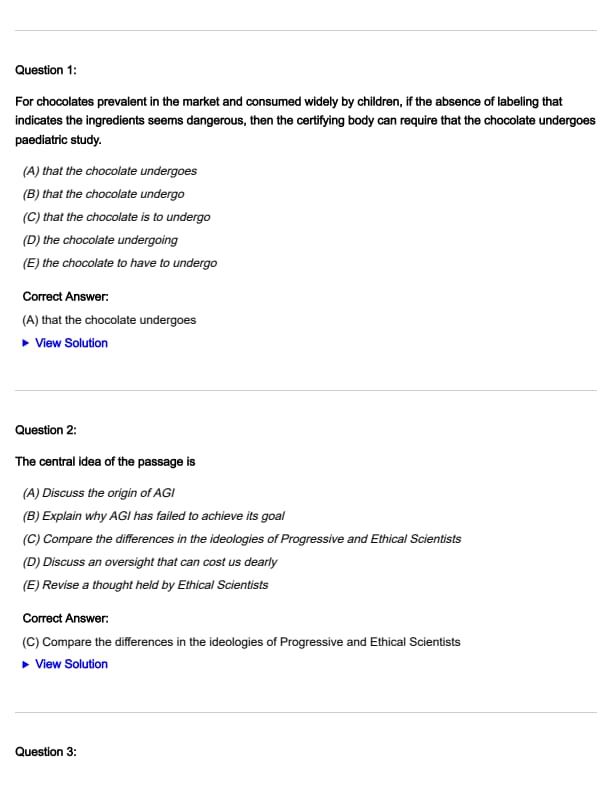
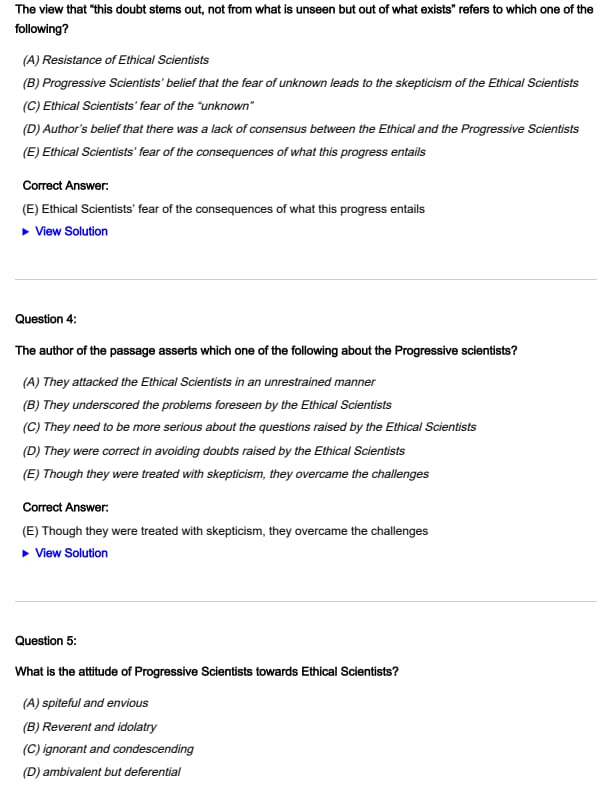
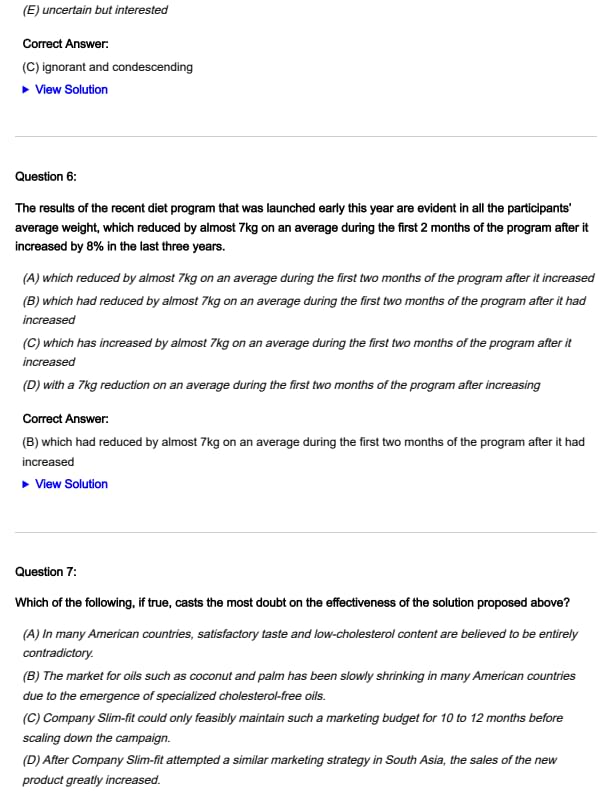
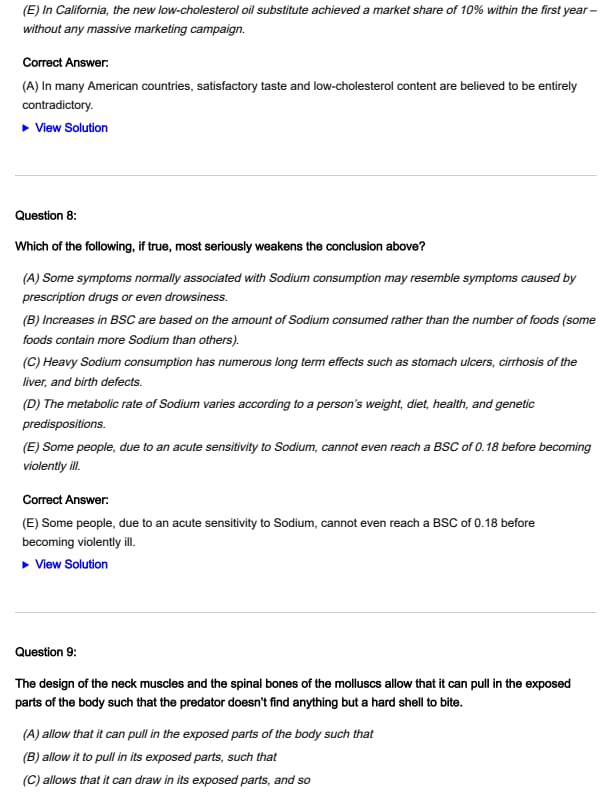
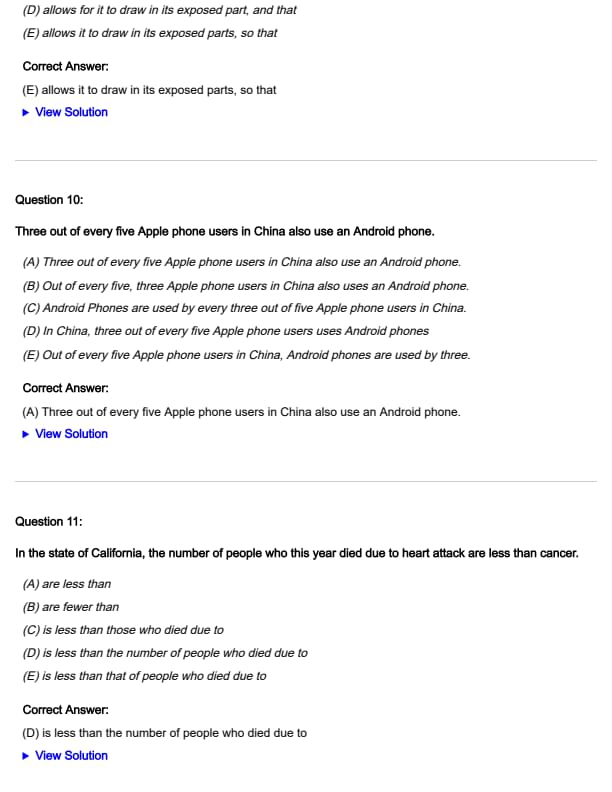
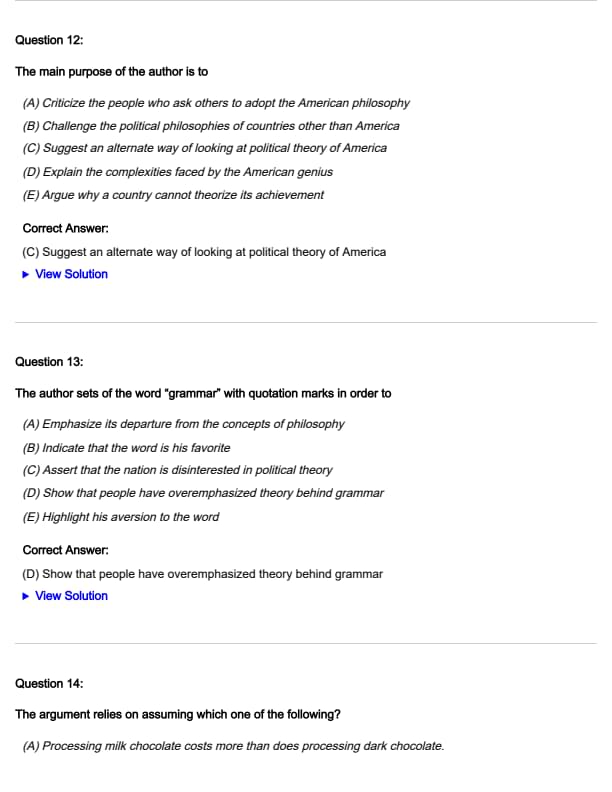
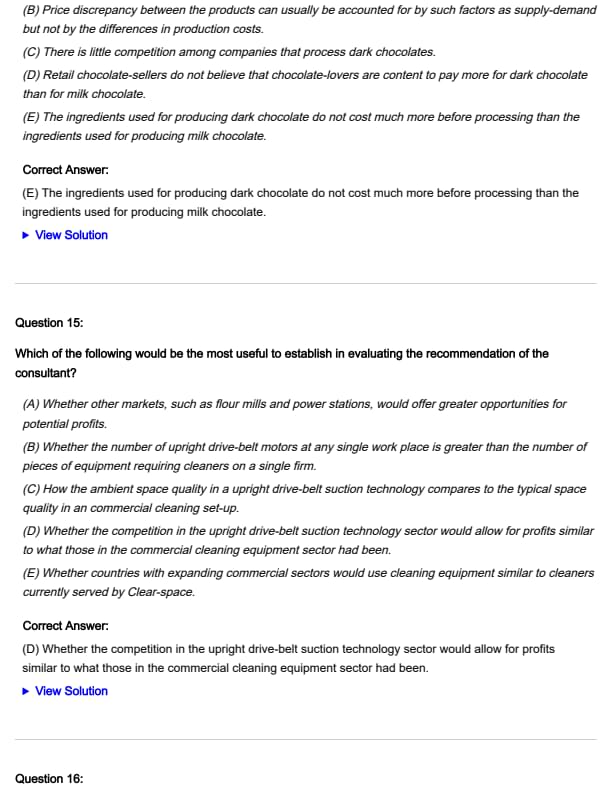
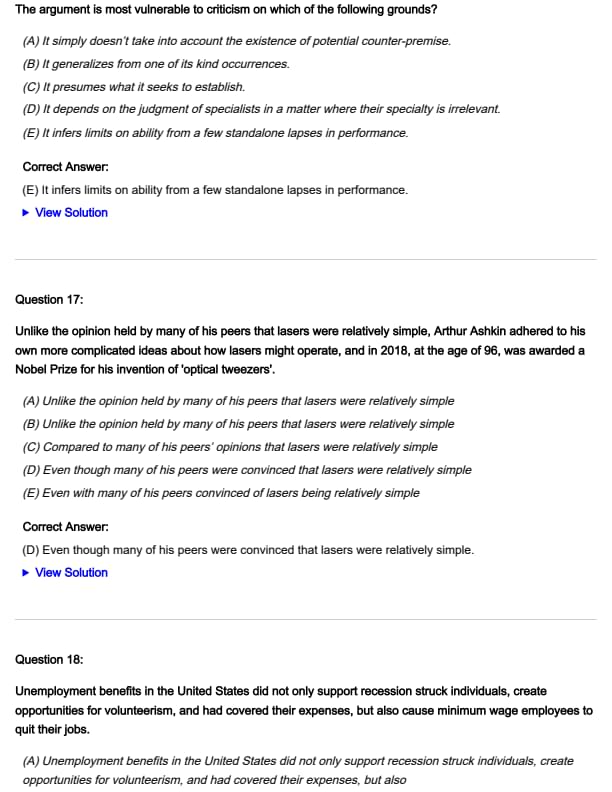
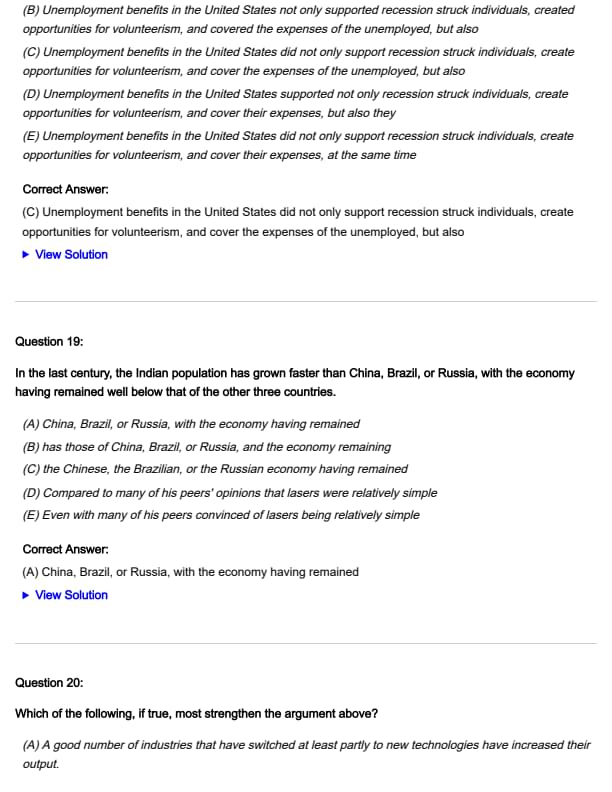
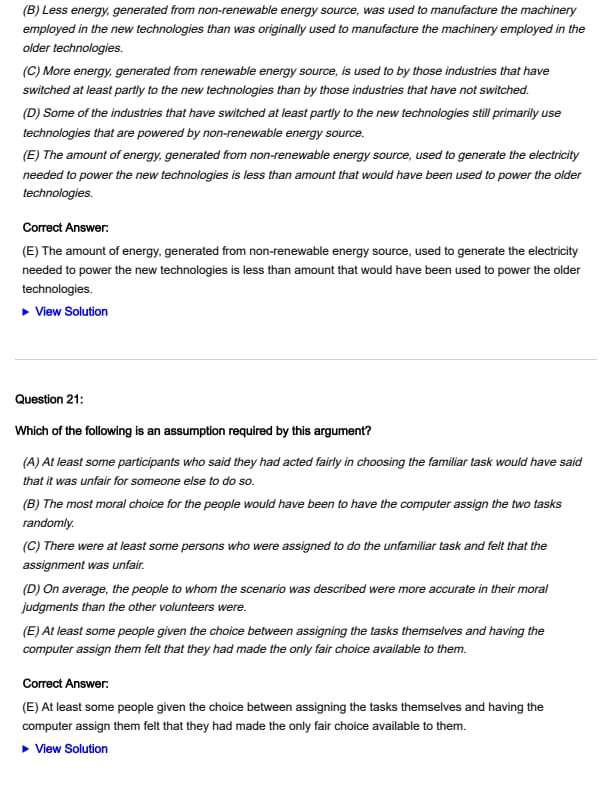
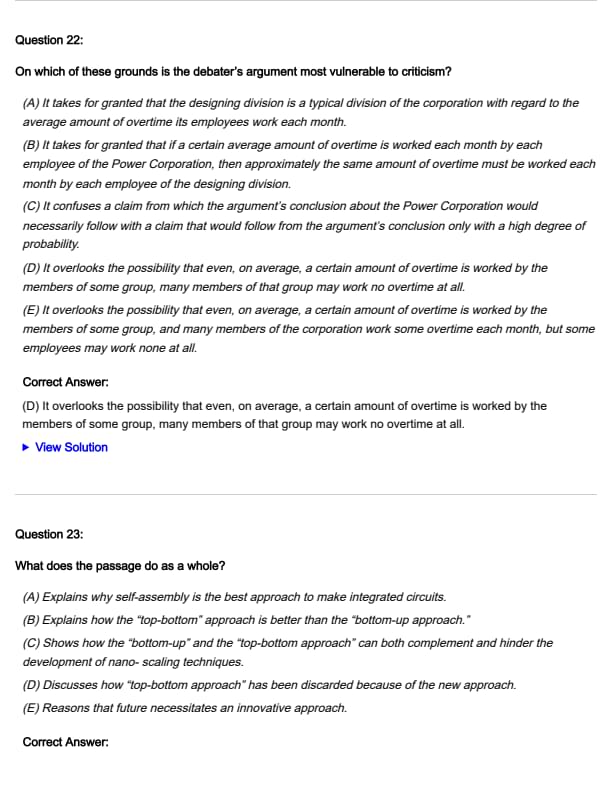
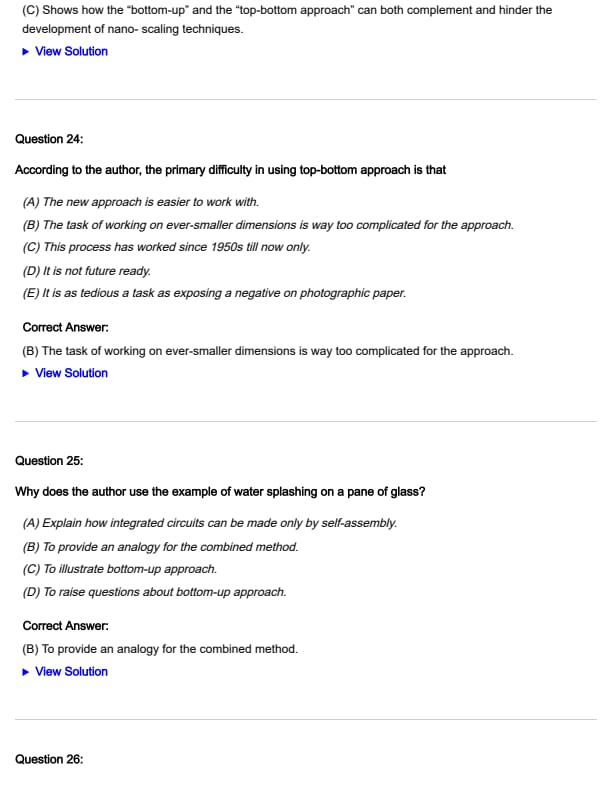
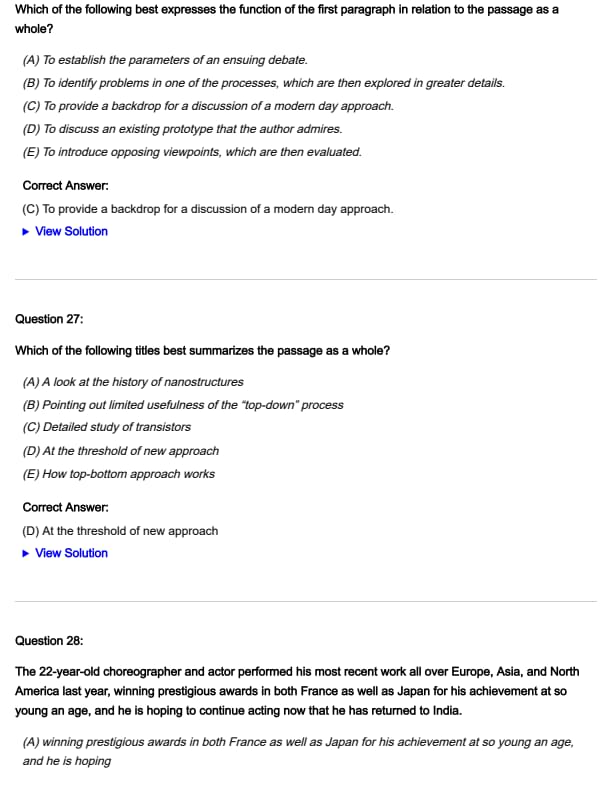
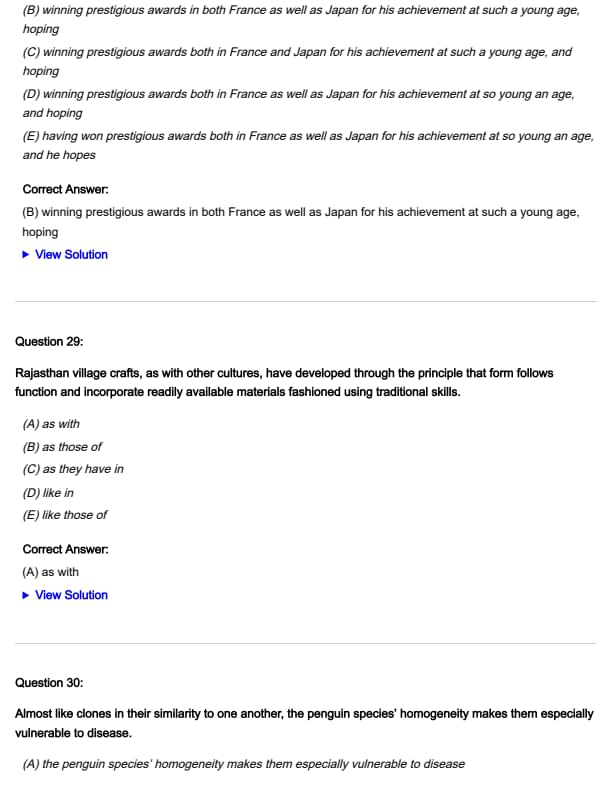
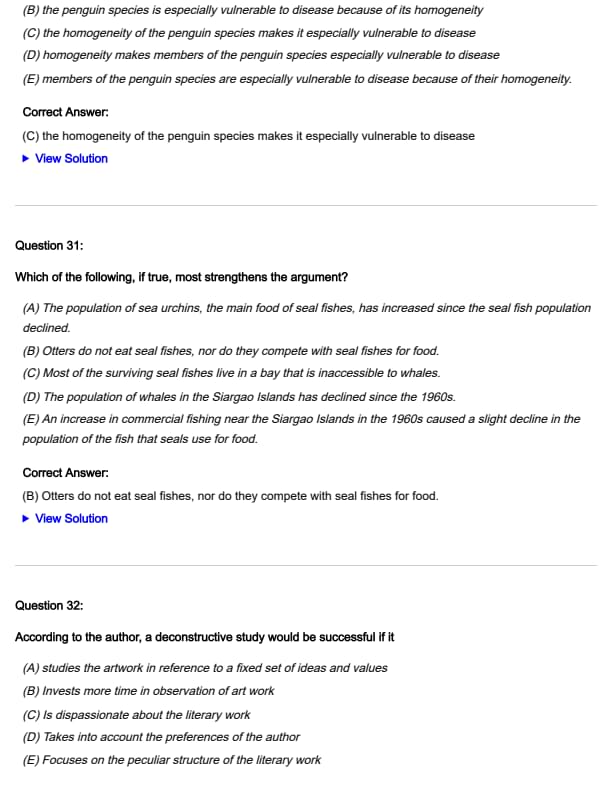
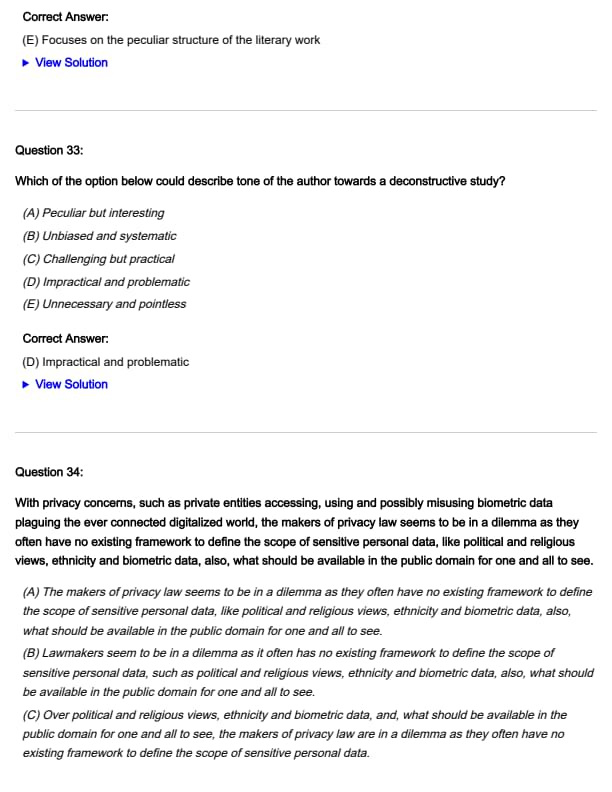
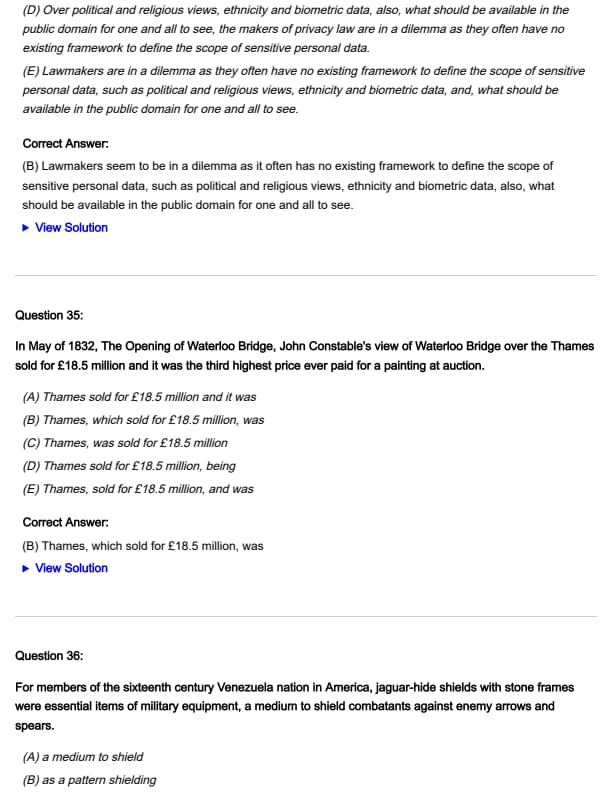
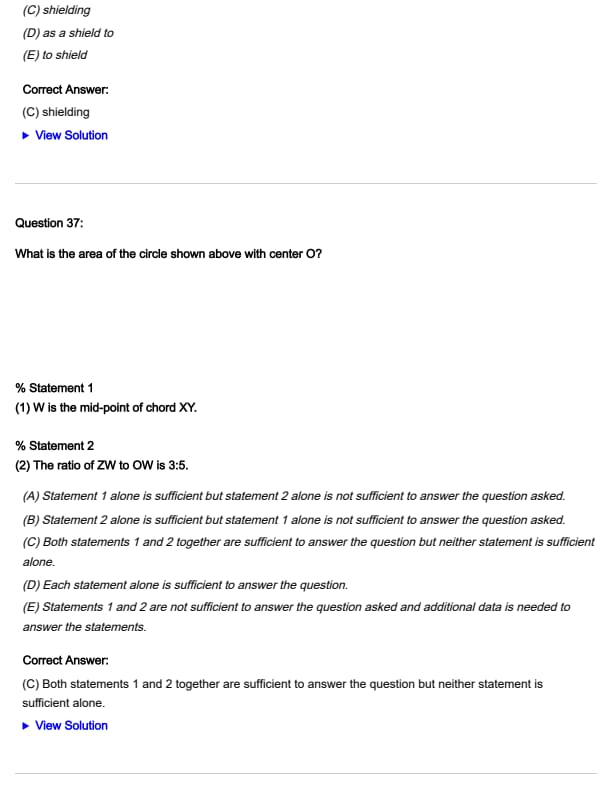
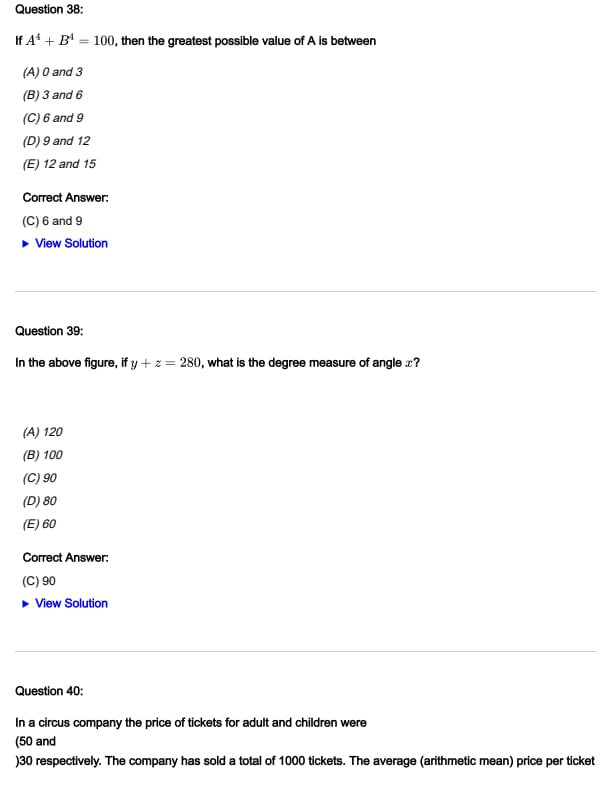
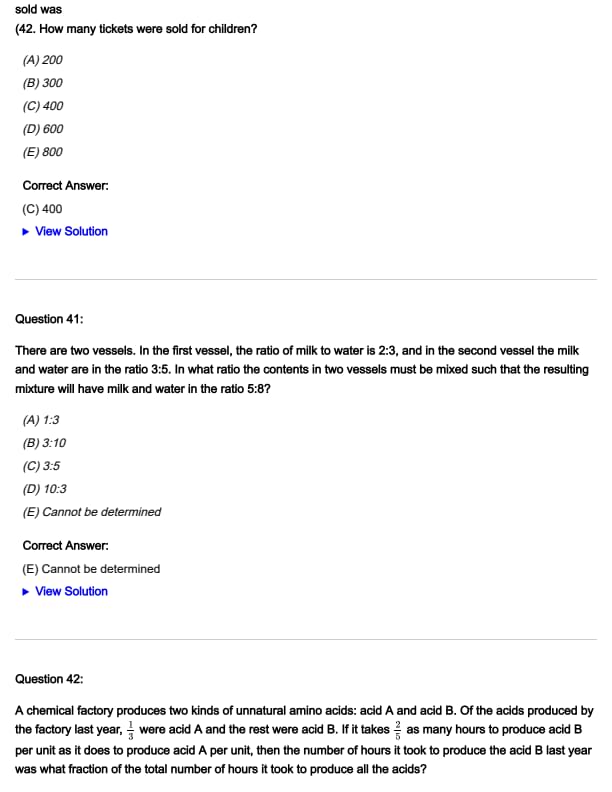
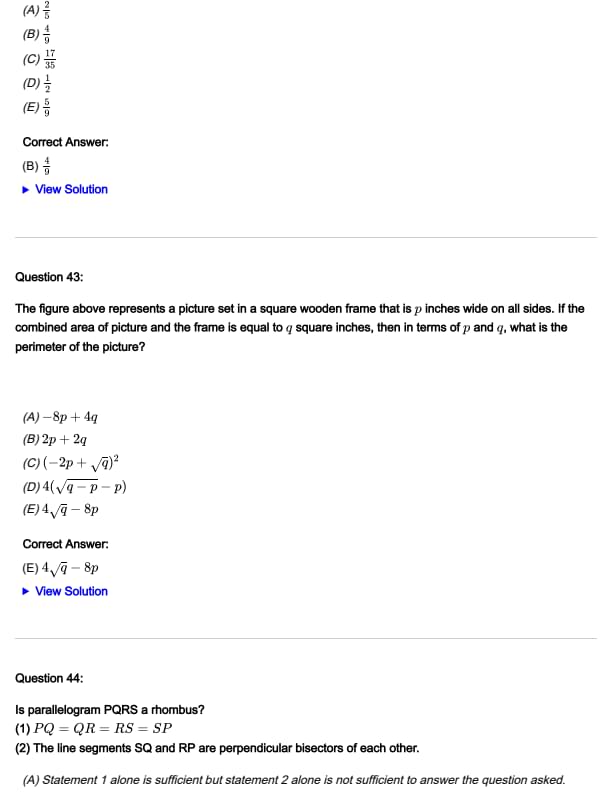
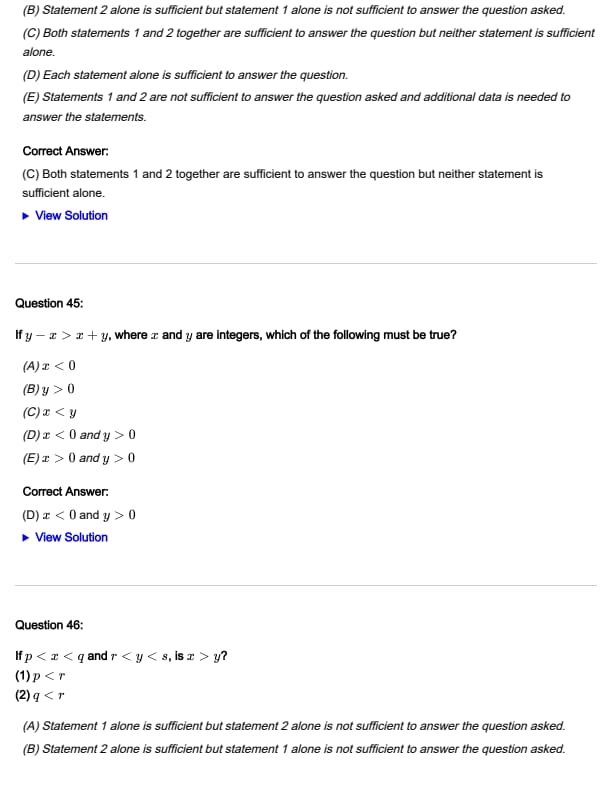
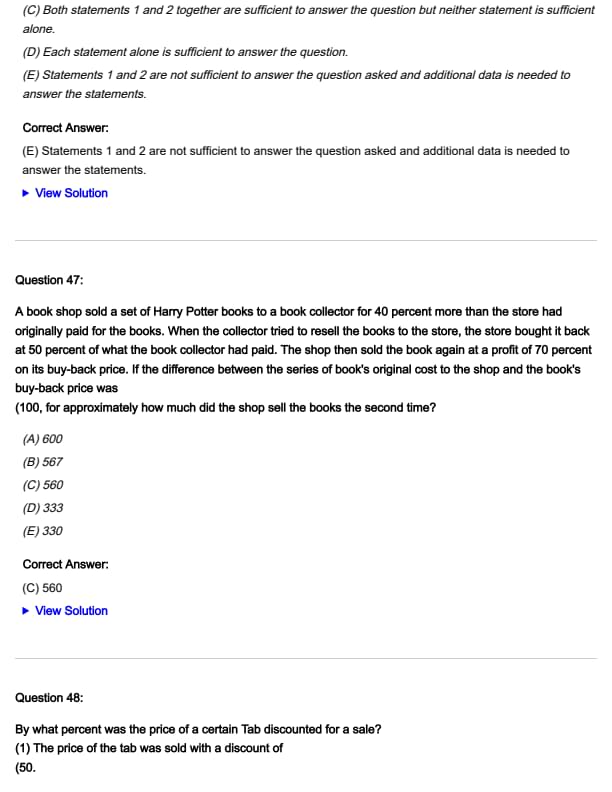
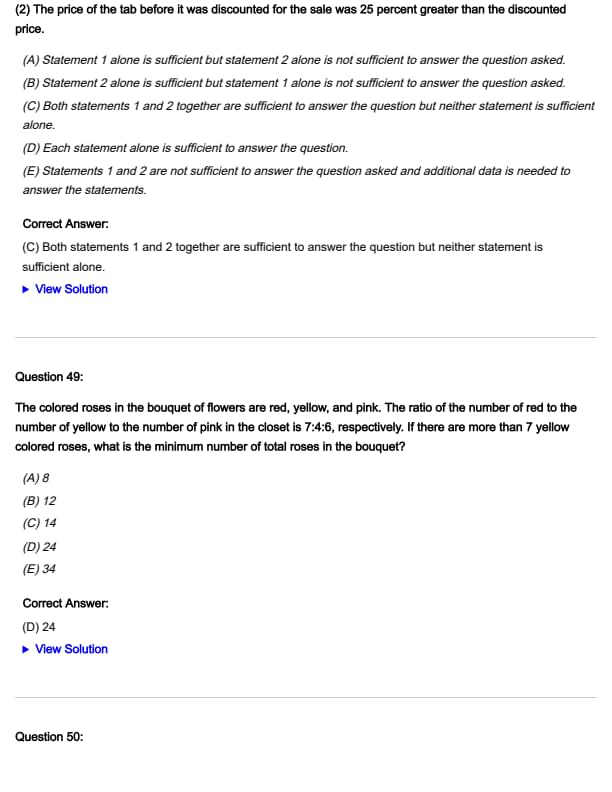
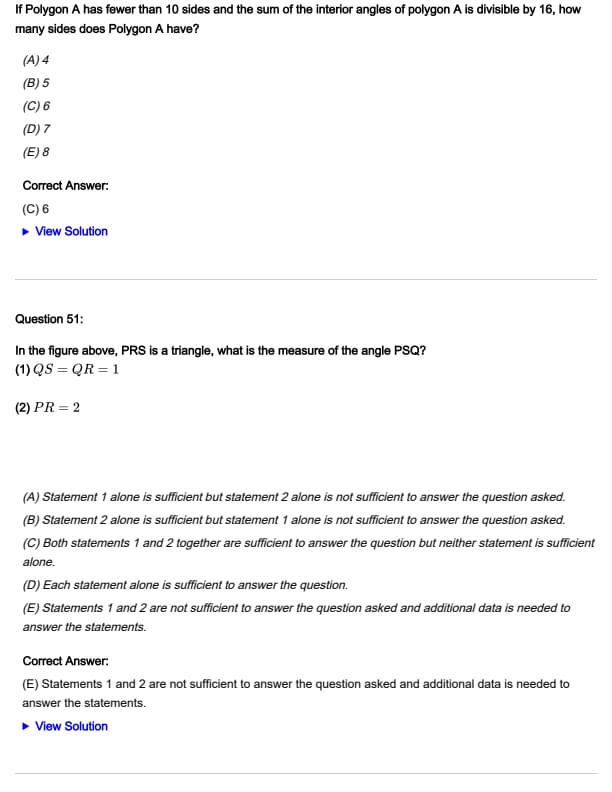
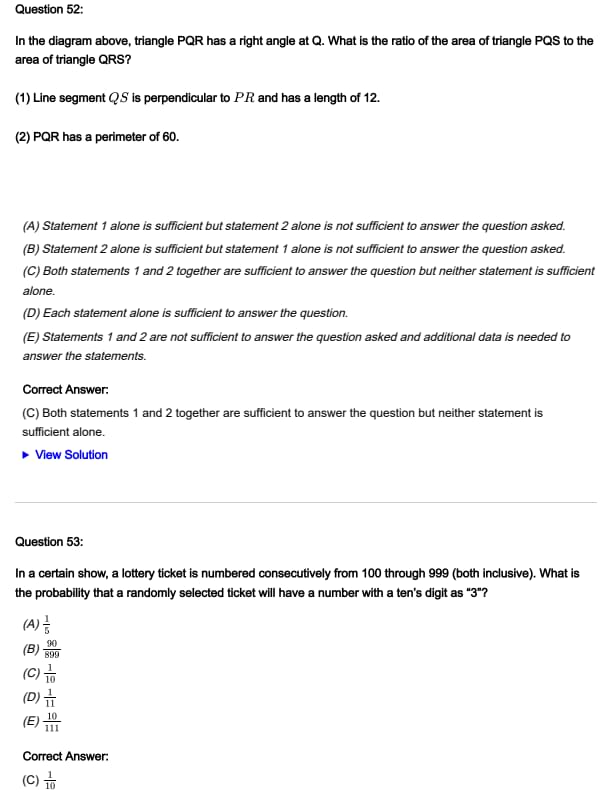
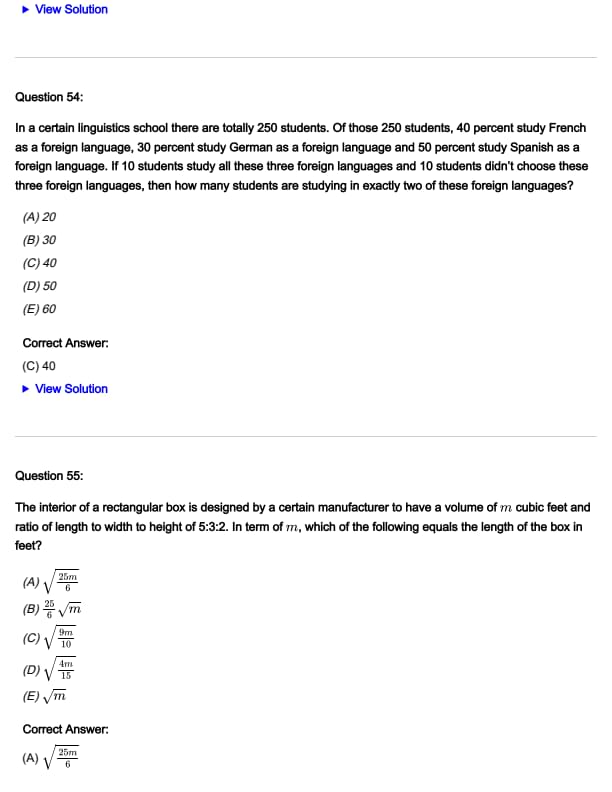
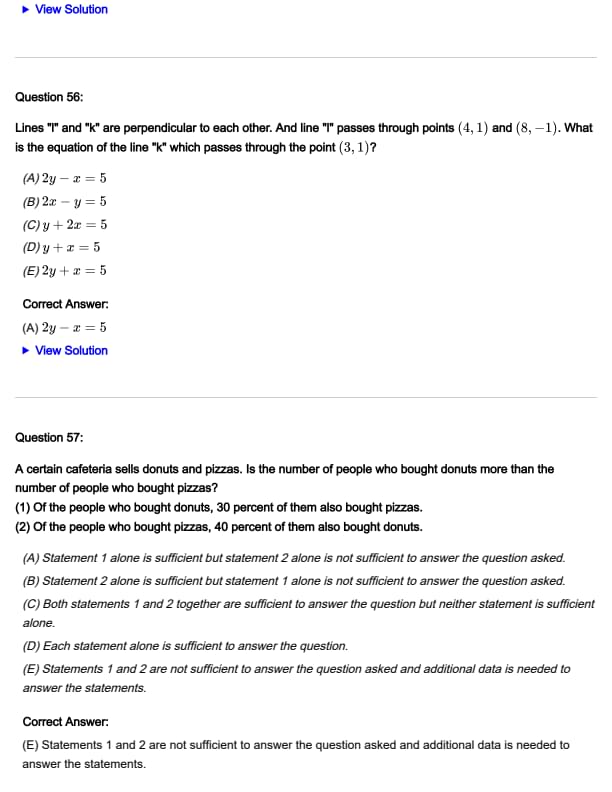
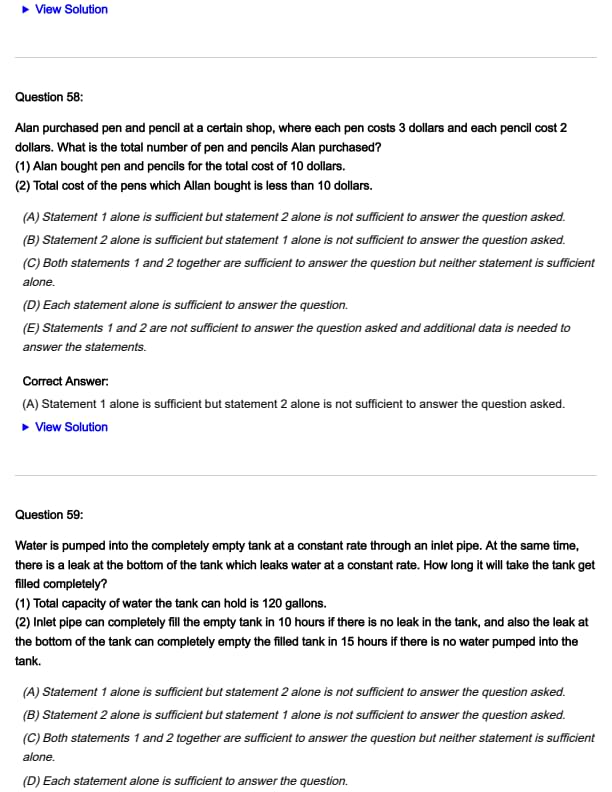
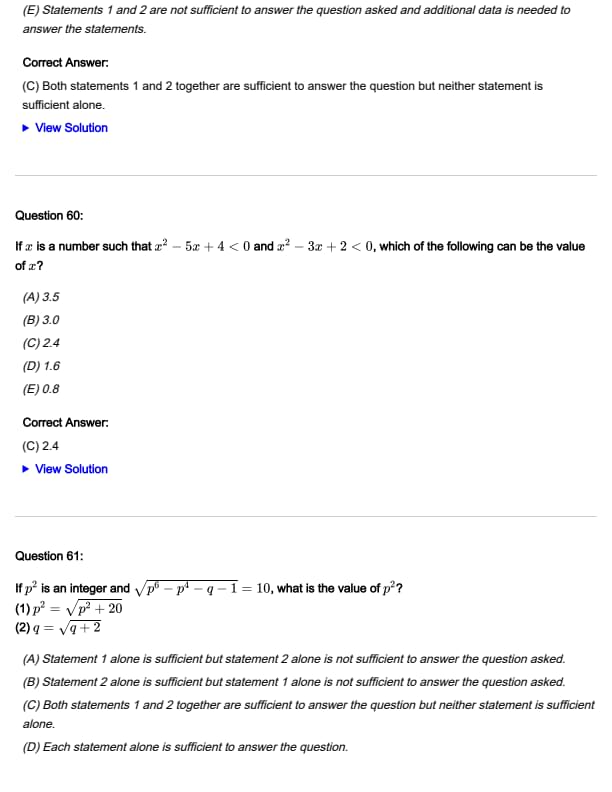
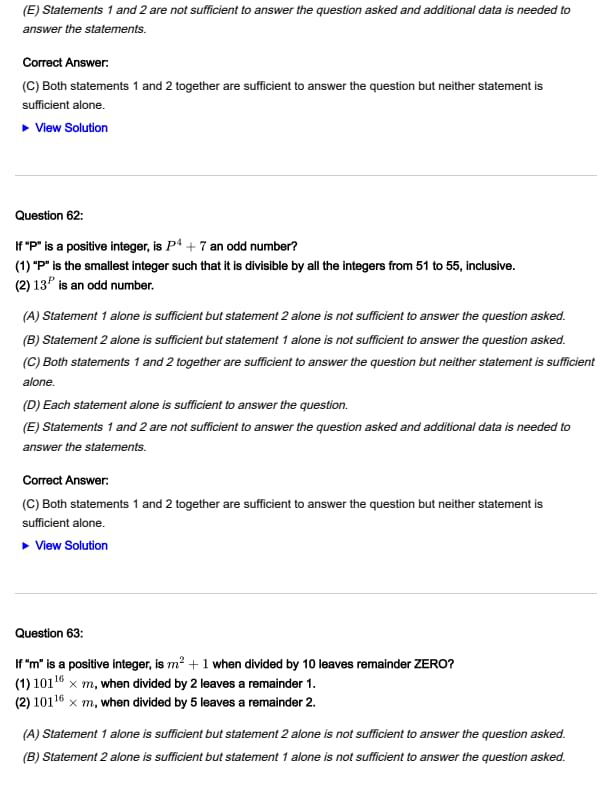
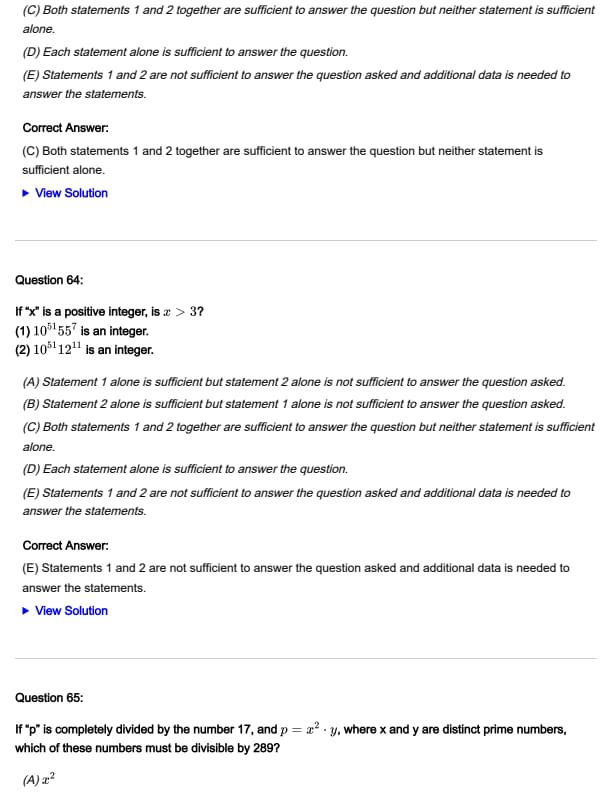
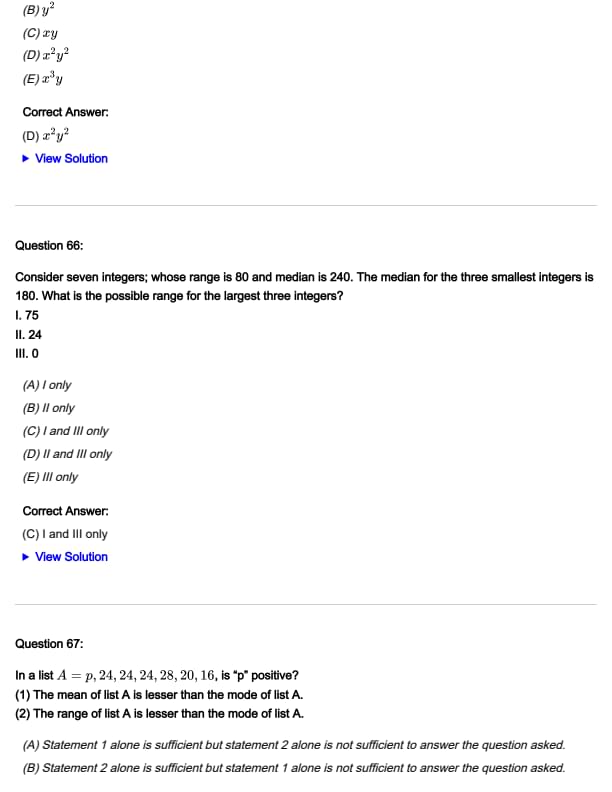
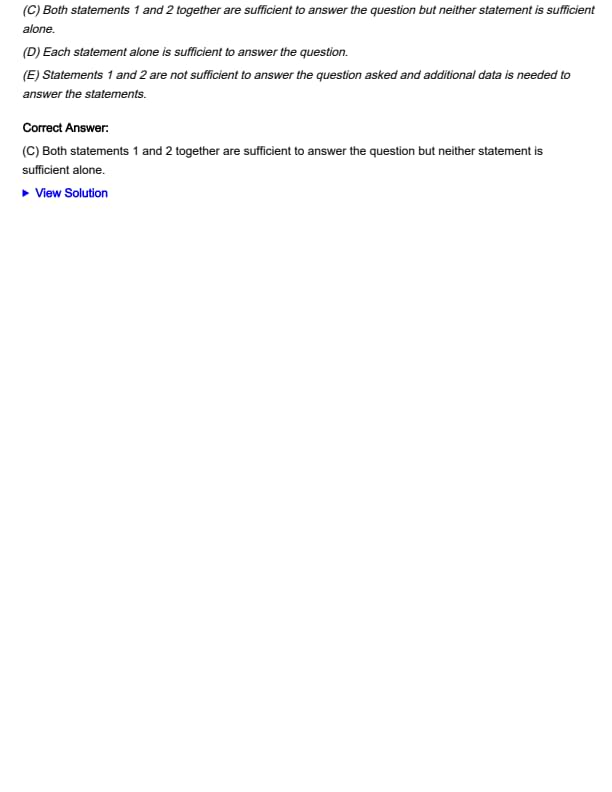

-modified.png?h=56&w=56&mode=stretch)


Comments